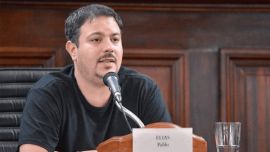The death of Federal Judge Claudio Bonadio, the iconic spearhead of Kirchnerite corruption trials, early Tuesday makes the Justice portfolio a natural candidate for this week’s “Ministry Positions” column. Unlike various Cabinet posts, this ministry respects the formal hierarchy of the ruling coalition – Justice and Human Rights Minister Marcela Miriam Losardo, 61, represents its presidential wing and Justice Secretary Juan Martín Mena, 40, the vice-presidential. It might be noted that although the related Justice and Security portfolios both have female ministers (with Sabina Frederic the subject of this column a fortnight ago) gender solidarity does not translate into ideological with Frederic more closely aligned with Mena than with her colleague.
These differences do not run deep enough to alter the direction of judicial reform proposals but they do affect their pace although perhaps the biggest inhibition lies outside the ministry – namely the overwhelming centrality of debt negotiations. At a time when the government is trying to minimise the sovereign debt falling under foreign jurisdiction, it would not be a smart move to go monkeying around with the Argentine legal system and undermine its credibility yet further. There is thus a basic incompatibility between the aspiration to reach a debt settlement by the last day of next month and announcing a drastic judicial reform in the presidential state-of-the-nation message to open Congress on the first day.
The main aims of judicial reform are shared by moderates and extremists alike – to dilute the power of federal judges and to banish the intelligence services from the judicial sphere (see page 10 for the latter). Transformation of a cumbersome and dysfunctional judiciary is imperative and yet the suspicion remains that the main motive for reform zeal is to make life easier for Vice-President Cristina Fernández de Kirchner rather than harder for criminals by ensuring that independent justice in general and Kirchnerite corruption trials in particular are as dead as Bonadio.
Yet for all the broad agreement the devil lies in the detail. President Fernández has entrusted judicial reform to Losardo (whom he knows from his baby steps in public life as his legal advisor at the Insurance Superintendancy three decades ago) and Strategic Affairs Secretary Gustavo Beliz (Justice Minister when Fernández first became Cabinet chief in 2003 although obliged to resign the next year after denouncing Jaime Stiuso of Alberto Nisman documentary fame as a superspy). But many Kirchnerite elements in the coalition are apprehensive that this team chosen by law professor Fernández might heed legal as much as political criteria and proceed too cautiously.
Meanwhile Argentina has a Justice Minister (Losardo) and Secretary (Mena) but is missing one key link – since previous president Mauricio Macri dumped Alejandra Gils Carbó in late 2017, Argentina has lacked an Attorney-General and the odds are against having one any time soon with the problems facing the nomination of the federal judge Daniel Rafecas (who helped to convict Cristina’s vice-president Amado Boudou but is nevertheless questioned by the Senate opposition for his cursory dismissal of Nisman’s report accusing the current vice-president of collusion with Iranian impunity for the 1994 AMIA terrorist attack). Thus hard to transfer wiretapping from intelligence to the Attorney-General, as planned, if there is none.
Little enough to say about either Losardo or Mena. The minister (who held the latter’s post between 2005 and 2009) is the lawyer who has worked closest with Alberto Fernández while the Kirchnerite Mena is an expert in penal law and penitentiary systems who is, however, most valued for his brief 2014-15 stint as deputy chief of SIDE intelligence since this presumably equips him to help weed out the spooks from the judicial system.
The Justice Ministry is an inherent contradiction with the separation of powers as a potential Executive Branch parallel to the Supreme Court – there was never a “Legislation Ministry” to tell Congress what to do. Yet this role as an executive watchdog has always been more apparent than real. Even in those periods when a strong administration largely overrode the separation of powers within Argentina’s hyper-presidential democracy, the Justice Ministry was virtually never its chosen instrument. And since 1998 the Council of Magistrates (which represents political parties and the judicial and legal professions as well as the presidency) has been a much more direct factor in vetting the judiciary even if federal judges remain too powerful for this government’s liking. Other potential legal watchdogs lurk in the shadows such as the Ombudsman (invariably a nebulous figure) and the Attorney-General, who has been important at times.
The ministry’s sway over the justice system is thus somewhat nominal but it has a rather more exclusive responsibility for something which could place it on a collision course with the other “Human Rights” half of its title – namely, the Federal Penitentiary Service. The previous Kirchnerite governments were fairly successful in keeping human rights identified with an increasingly distant 1976-83 military dictatorship but at some point these rights are going to have to enter this century and prison conditions might well be the starting-point. Prison overcrowding exceeds capacity by 25 percent on average with fiscal constraints working against building new prisons and perhaps the worst of it is that around 60 percent of the 70,000-plus imprisoned are not even convicts in the strict sense of the word – this pressures the first half of the ministry’s job description to push through judicial reforms to speed up trials.
Turning to history, for almost a century (1854-1949) there was a Justice and Public Education Ministry in that order, a suggestive indication of priorities in those days – in that period there were 57 different ministers (four of them future presidents). In 1949 Peronism created the first Justice Ministry in its own right which continued until 1983 with a couple of interruptions (the most important in the 1956-66 period when it became a department under the Education Ministry, which was also the case during the 1983- 9 Raúl Alfonsín presidency). In 1989 Carlos Menem expanded the title to Justice, Security and Human Rights Ministry while in 2010 the creation of the Security Ministry led to its present designation of Justice and Human Rights Ministry (also briefly held in the 1999-2001 interim period).
Since 1949 there have been 33 Justice ministers, including Beliz and brand-new Río Turbio trustee Aníbal Fernández (among those prominent in recent news) and current Supreme Court Justice Horacio Rosatti. Around 11,500 employees remained after creation of the Security Ministry in 2010 with a budget of over 21 billion pesos in 2018.
Such is the panorama as the new ministry enters its third month amid a judicial scenario now minus Bonadio.




















Comments